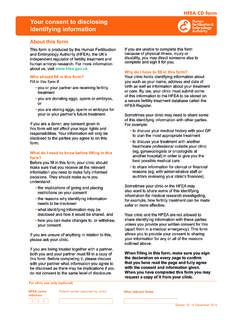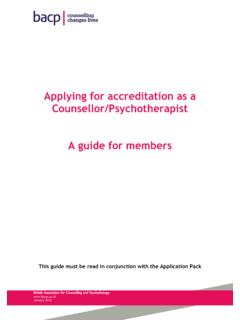Transcription of Code of practice
1 9th Edition Edition To be published October 2018 Human Fertilisation and Embryology Authority 10 Spring Gardens London SW1A 2BU t 020 7291 8200 e w practiceCode of code of practice 9th EDITION TO BE PUBLISHED OCTOBER 2018 HFEA copyright 2018 The text of this document (this excludes, where present, the Royal Arms and all departmental or agency logos) may be reproduced free of charge in any format or medium provided that it is reproduced accurately and not in a misleading context. The material must be acknowledged as HFEA copyright and the document title specified. Where third party material has been identified, permission from the respective copyright holder must be sought.
2 Any enquiries related to this publication should be sent to: Human Fertilisation and Embryology Authority 10 Spring Gardens London SW1A 2BU t 020 7291 8200 e Edition To be published 2018 Contents (Version ) Human Fertilisation and Embryology Authority Contents Version User guide Regulatory principles for licensed centres 1. Person Responsible2. Staff3. Counselling4. Information to be provided prior to consent5. Consent to treatment, storage, donation, training and disclosure of information6. Legal parenthood7. Multiple births8. Welfare of the child9. Preimplantation genetic screening (PGS)10. Embryo testing and sex selection11. Donor recruitment, assessment and screening12.
3 Egg sharing arrangements13. Payments for donors14. Surrogacy15. Procuring, processing and transporting gametes and embryos17. Storage of gametes and embryos18. Witnessing and assuring patient and donor identification19. Traceability20. Donor assisted conception21. Intra-cytoplasmic sperm injection (ICSI)Contents (Version ) Human Fertilisation and Embryology Authority 22. Research and training23. The quality management system24. Third party agreements25. Premises, practices and facilities26. Equipment and materials27. Adverse incidents28. Complaints29. Treating people fairly30. Confidentiality and privacy31. Record keeping and document control32. Obligations and reporting requirements of centres33.
4 Mitochondrial donationUser guide (Version ) Human Fertilisation and Embryology Authority User guide Version What is the purpose of the code of practice ? The Human Fertilisation and Embryology Act 1990 ( the Act ) covers the use and storage of sperm, eggs and embryos for human application, as well as all research involving the use of live human and admixed embryos. One of the ways we help licensed centres comply with the Act is by publishing the code of practice . This is because we have a duty under the Act to maintain a document that gives guidance about licensed activities and the people who carry them out. The code of practice contains regulatory principles for licensed centres, and guidance notes which provides guidance to help clinics deliver safe, effective and legally compliant treatment and research.
5 guidance in the code of practice also serves as a useful reference for patients, donors, donor-conceived people, researchers and those working in the fertility sector. Regulatory principles for licensed centres The Act requires us to maintain a statement of the general principles that we consider should be followed in carrying out licensed activities covered by the Act. The principles inform every part of this code of practice and provide: a summary of the key behaviours and outcomes we expect licensed centres to demonstrate, and a means of communicating the areas of compliance we regard as notes Each of the 33 guidance notes in the code of practice cover one subject area, to make it easier for users to find what they are looking for.
6 guidance notes are made up of the following sections: Mandatory requirementsThese sections include relevant extracts from the Act, licence conditions, and references toGeneral Directions. The person responsible is expected to be familiar with and comply with allmandatory requirements that apply to their : The code of practice does not provide a complete guide to the Act and othermandatory requirements. Nor is it a substitute for reading the Act. Interpretation of mandatory requirementsWe have provided an interpretation of the law where we feel centres may find it helpful, especiallywhere the law is very : Our interpretations are intended only to aid understanding and are not definitive.
7 GuidanceThis guidance is intended to help centres comply with mandatory guide (Version ) Human Fertilisation and Embryology Authority Other legislation, professional guidelines and informationThis section lists other useful external information, including links to relevant and enforcement We have a duty to promote compliance with the Act and the code of practice . If we become aware that a centre has not complied with the legislation or the code of practice , we may take action in line with the Compliance and Enforcement Policy. We will consider a centre s failure to observe any provision in the code of practice in the circumstances set out in section 25(6)(a) and (b) of the Act.
8 Regulatory principles (Version ) Human Fertilisation and Embryology Authority Regulatory principles for licensed centres Version The regulatory principles are a high-level statement that underpin our key regulatory priorities from the Human Fertilisation and Embryology Act 1990. They provide: a summary of the key behaviours and outcomes we expect licensed centres to demonstrate, and a means of communicating the areas of compliance we regard as key, to the Person Responsibleand staff at licensed centres, patients, donors, donor-conceived people and the regulatory principles inform every part of this code of practice and should be read in conjunction with each of its guidance notes.
9 Regulatory principles We expect the person responsible to ensure that their licensed centre demonstrates adherence to the following principles when carrying out activities licensed under the Human Fertilisation and Embryology Act 1990. Licensed centres must: prospective and current patients and donors fairly, and ensure that all licensed activitiesare conducted in a non-discriminatory respect for the privacy, confidentiality, dignity, comfort and well-being of prospective andcurrent patients and respect for the special status of the embryo when conducting licensed account of the welfare of any child who may be born as a result of the licensed treatmentprovided by the centre, and of any other child who may be affected by that prospective and current patients and donors sufficient.
10 Accessible and up-to-dateinformation to enable them to make informed that patients and donors have provided all relevant consents before carrying out anylicensed all licensed activities with skill and care and in an appropriate environment, in line withgood clinical practice , to ensure optimum outcomes and minimum risk for patients, donors that all premises, equipment, processes and procedures used in the conduct oflicensed activities are safe, secure and suitable for the that all staff engaged in licensed activity are competent and recruited in sufficientnumbers to guarantee safe clinical and laboratory practiceRegulatory principles (Version ) Human Fertilisation and Embryology Authority accurate records and information about all licensed all adverse incidents (including serious adverse events and reactions) to us, investigateall complaints properly, and share lessons learned that all licensed research by the centre meets ethical standards, and is done onlywhere there is both a clear scientific justification and no viable alternative to the use ofembryos, all licensed activities with regard for the regulatory framework governing treatment andresearch involving gametes or embryos within the UK, including.


